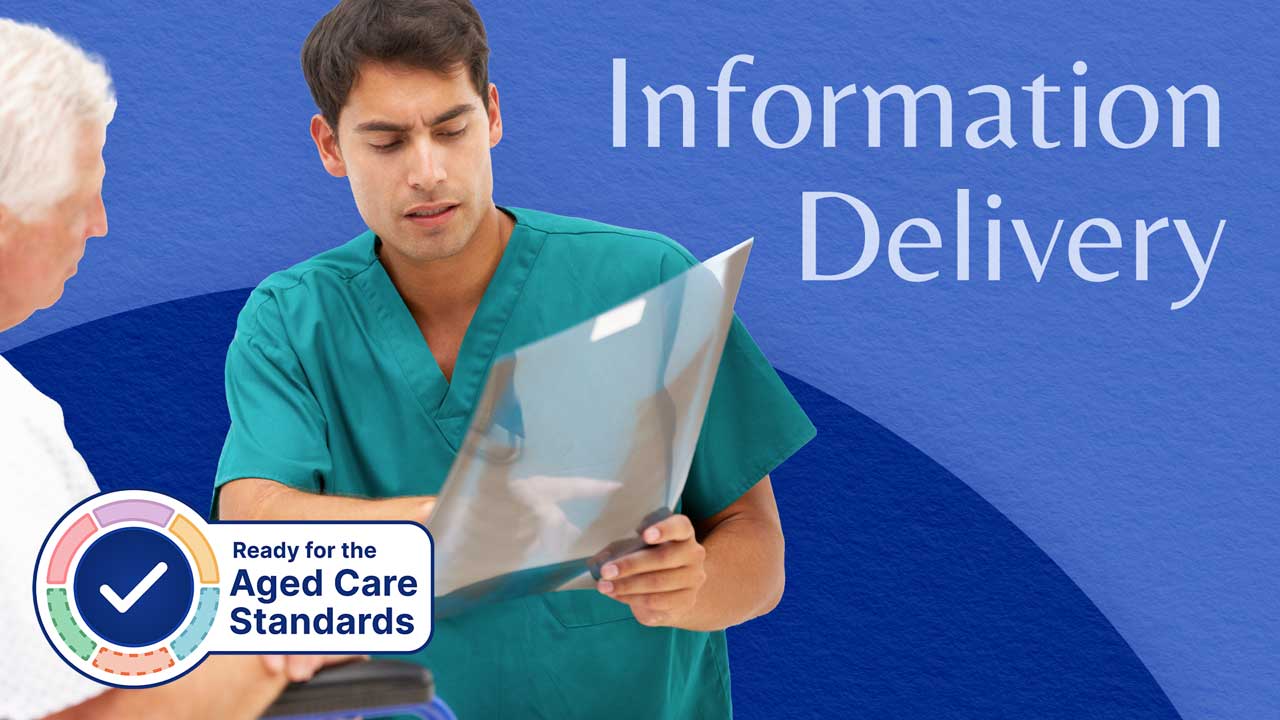A study once found that less than half of hospitalised patients could remember their diagnosis or the names of their medications (IHC 2011).
Additionally, it is estimated that about 50% of patients with chronic illnesses do not take their medication in the way it was prescribed (Kim et al. 2018).
A simple solution for these issues - and others - is the delivery of clear and high-quality information to clients (Ciaglia 2017).
Effectively Communicating Information in Healthcare
Effective communication between healthcare staff and clients is an essential component of providing high-quality and safe care (ACSQHC 2016).
As well as improving client outcomes and satisfaction, effective communication is crucial in preventing errors, unnecessary distress and inappropriate interventions (ACSQHC 2016).
Every client has the right to access clear, timely information about the care they are receiving. You may assume the information you provide is easy to comprehend. Yet, 60% of Australians find it difficult to understand complicated healthcare concepts and information (Ciaglia 2017; CEC 2019).
Furthermore, communication issues are among the most common underlying causes of complaints about Australia’s healthcare system (ACSQHC 2018).
These communication complaints often include:
- Poor attitude or manners from staff
- Inadequate information
- Incorrect or misleading information
- Staff not accommodating the client’s special needs.
(OHO 2015)
This suggests there is significant room for improvement.

What Do Clients Need to Know?
You should clearly communicate the following information to clients:
- Their diagnosis and prognosis, and what they mean
- Any costs/expenses for the client
- Investigation, treatment and/or management options available
- Medications (including what they do, dosages and how to use them)
- Services available to them
- Referrals to other health services
- Health literature and education opportunities
- How to access their own health information (e.g. care plans, test results)
- Their rights
- A discharge plan that includes:
- Actions the client needs to take towards their health
- A treatment plan and medication list
- Any future tests or appointments that are needed
- Information that needs to be discussed with the client’s GP
- What the client should expect at their next place of care (if being transferred)
- Warning symptoms and signs to look out for and what to do if they occur.
(Queensland Health 2023; ACSQHC 2016)
Responsible Information Delivery in Aged Care
Standard 3: Care and Services - Outcome 3.2: Delivery of care and services of the strengthened Aged Care Quality Standards (Action 3.2.9) states that aged care workers should be supported to:
- Understand older people’s unique communication styles, including those with dementia or who have difficulty communicating
- Effectively communicate, both verbally and non-verbally, with older people.
(ACQSC 2024)
Naturally, this includes effectively communicating information with the older people in your care.
How to Effectively Communicate Information to Clients
The Australian Commission on Safety and Quality in Health Care lists the following as the essential components of effectively exchanging information with clients:
- Fostering relationships
- Two-way exchange of information
- Conveying empathy
- Engaging clients in decision-making and care planning
- Managing uncertainty and complexity.
(ACSQHC 2016)
Read: Communication Skills
Issues Caused by Unclear Information
If clients are not provided with adequate access to clear information, there may be implications such as:
- Misdiagnosis
- Inappropriate treatments
- Poor health outcomes
- Hospital sentinel events
- Client complaints
- Adverse drug events
- Readmission
- Decreased quality of care
- Delayed treatment.
(ACSQHC 2016)
Clients Who are at Higher Risk of Harm
The following clients are at an increased risk of harm if presented with unclear or complicated information:
- Aboriginal and Torres Strait Islander people
- Older people
- People living with disability
- People who are homeless
- People who are culturally or linguistically diverse
- People living with mental illness
- People undergoing surgery
- Children
- People receiving palliative care
- People in intensive care units
- People with several comorbidities.
(ACSQHC 2016)
It is imperative that these clients are provided with information that matches their level of understanding, and that it is communicated in a clear manner.
Practical Tips for Conveying Information

- As identified by the ACSQHC, many clients have a limited understanding of healthcare concepts. Individually gauge each client’s level of understanding and communicate with them accordingly.
- Do not assume English proficiency or a client’s level of understanding.
- Speak clearly and slowly.
- Confirm that clients understand what has been explained to them.
- Encourage the client to ask questions.
- Improve your own health literacy skills so that you can communicate with clients more effectively.
- Ensure the client can demonstrate an understanding of the information provided to them. Consider asking them to repeat it back to you.
- Ensure an interpreter is available if required.
- Ask the client about their needs and priorities.
- Ensure the client is notified if they need any kind of follow-up.
- Ensure the client is notified about any warning signs to look out for.
- Describe the roles of each member of the care team.
- Keep the client informed about their care plan.
- Keep the client informed about expected timeframes, tests or procedures that need to be performed, why certain decisions are being made etc.
- Check that the client is willing to follow any plans made.
- Follow up with the client post-discharge to monitor their progress.
(OHO 2015; Health.vic 2015; ACSQHC 2016)
Conclusion
All clients should be able to access adequate information about their condition and the services available to them. This must be communicated in a clear, easily understandable manner so that clients are well-informed and able to exercise autonomy.
Test Your Knowledge
Question 1 of 3
What percentage of Australians have difficulty understanding complicated healthcare concepts and information?
Topics
References
- Aged Care Quality and Safety Commission 2024, Standard 3: Care and Services, Australian Government, viewed 18 April 2024, https://www.health.gov.au/resources/publications/strengthened-aged-care-quality-standards-august-2025?language=en
- Australian Commission for Quality and Safety in Health Care 2018, Communicating With Patients and Colleagues, Australian Commission for Quality and Safety in Health Care, viewed 13 June 2023, https://c4sportal.safetyandquality.gov.au/communicating-with-patients-and-colleagues
- Australian Commission for Quality and Safety in Health Care 2016, Patient-clinician Communication in Hospitals, Australian Government, viewed 13 June 2023, https://www.safetyandquality.gov.au/publications-and-resources/resource-library/patient-clinician-communication-hospitals-communicating-safety-transitions-care-information-sheet-healthcare-providers
- Better Health Channel 2015, Confidentiality and Privacy in Healthcare, Victoria State Government, viewed 13 June 2023, https://www.betterhealth.vic.gov.au/health/servicesandsupport/confidentiality-and-privacy-in-healthcare
- Ciaglia, A 2017, ‘Why is High Quality Health Information Important for Patients?’, Patient Research Exchange, 10 July, viewed 13 June 2023, https://www.patientresearchexchange.org/stories/detail/why-is-high-quality-health-information-important-for-patients
- Clinical Excellence Commission 2019, Health Literacy Framework: A Guide to Action, New South Wales Government, viewed 13 June 2023, https://www.cec.health.nsw.gov.au/__data/assets/pdf_file/0008/487169/NSW-Health-Literacy-Framework-2019-2024.pdf
- Health.vic 2015, Communicating Effectively, Victoria State Government, viewed 13 June 2023, https://www.health.vic.gov.au/patient-care/communicating-effectively
- Institute for Healthcare Communication 2011, Impact of Communication in Healthcare, Institute for Healthcare Communication, viewed 13 June 2023, https://healthcarecomm.org/about-us/impact-of-communication-in-healthcare/
- Kim, J, Combs, K, Downs, J & Tillman III, F 2018, ‘Medication Adherence: The Elephant in the Room’, Medication Management, viewed 13 June 2023, https://www.uspharmacist.com/article/medication-adherence-the-elephant-in-the-room
- The Office of the Australian Information Commissioner 2023, Access Your Health Information, Australian Government, viewed 13 June 2023, https://www.oaic.gov.au/privacy/health-information/access-your-health-information/
- Office of the Health Ombudsman 2015, Effective Communication in Healthcare, Office of the Health Ombudsman, viewed 13 June 2023, https://web.archive.org/web/20170218211823/https://www.oho.qld.gov.au/wp-content/uploads/2015/10/Effective-communication-in-healthcare.pdf
- Queensland Health 2023, Guide to Informed Decision-making in Health Care, Queensland Government, viewed 18 April 2024, https://www.health.qld.gov.au/__data/assets/pdf_file/0019/143074/ic-guide.pdf
 New
New 
